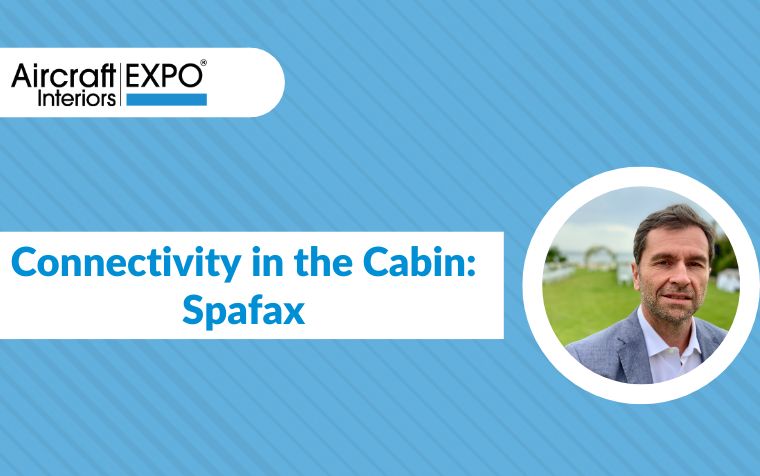The AIX team sat down with aerospace thought-leaders, market disruptors and established companies to discuss how Inflight Entertainment and Connectivity (IFEC) can keep up with changing passenger expectations.
The team spoke with Jean-Marc Thomas, Managing Director APAC, Spafax.
What are your predictions for connectivity in the cabin in 2023?
“Clearly, the connectivity and IFE industry is poised to experience tremendous growth in 2023 and beyond, as it’s projected to more than double by 2030 to more than $12 billion US. While the United States and Europe are currently leading the growth, connectivity will be a must-have for all airlines, even low-cost carriers, sooner than later.
Today’s passengers are increasingly vocal about their need for constant connectivity, and the rapidly maturing sector with numerous network options is making this possible.”
How do you see in-flight connectivity evolving in the next five years?
“With such growth on the horizon for in-cabin connectivity, within the next five years I fully expect we will see many more airlines rethinking their IFE strategies and taking a much closer look at how to best utilize their resources across those offerings.
For example, consider the concept of e-commerce platforms, where a passenger gets an extra financial incentive for purchasing through the airline’s platform. It’s about influencing the flow and using that connectivity in a smart way. I think we’ll see more partnerships being built like this, that will entice the passengers to use those airline channels versus just going straight to the internet for their retail purchases.”
Some estimations have put the “take-rate” for onboard Wi-Fi at just 6%, with some lamenting the poor connection and inability to stream content.
How do you see the role of Wi-Fi changing in the cabin going forward?
“That estimate doesn’t surprise me because oftentimes passengers have a poor experience trying to connect. In many cases they don’t even bother after a few failed attempts, or maybe somebody sends them picture and it burns through half of the free data allowance. That can be incredibly frustrating, so inevitably, that’s part of the reason why some passengers are not logging in.

Once connectivity becomes more stable and faster across the board, uptake will improve. I think the 6% ‘take-rate’ figure indicates that airlines need to think about hard about the options they have in place of onboard Wi-Fi. In the place of connectivity, what are they offering to create a positive experience for passengers? Can passengers easily connect from their own devices to the airline’s IFE platform to watch movies, play games, shop? If not, that’s a huge opportunity missed.”
The demand to stream content including on short and medium flights has proliferated.
How will airlines ensure they continue to meet this demand?
“Airlines must be creative and forward-thinking as they implement an IFE strategy that takes full advantage of connectivity, no matter the duration of the flight. But even short and medium flights present an opportunity for airlines and brands to create a better passenger experience and engage with them in a positive, impactful way.
To do this, airlines need to have solutions in place that enable them to access real-time data, update inventory quickly and painlessly, and generally become more reactive and nimbler to the needs of both their passengers and brand partners.”
The EU commission has unveiled plans for airlines to implement 5G technologies onboard for passengers.
Do you see this revolutionising onboard connectivity?
“Undoubtedly, granting passengers access to 5G networks while inflight would represent a significant leap forward in cabin connectivity. It will allow for streaming and most likely for digital media advertising as we know it on the ground. However, deploying 5G networks is a highly complex process, involving both technical and financial challenges.
The required investments in new infrastructure will be substantial and may prove cost-prohibitive for many airlines, even with the EU’s approval of the technology.
Additionally, as mentioned previously given the low adoption rate of inflight Wi-Fi by passengers, many airlines may be hesitant to make further investments in this area until there is a significant shift in customer behaviour. As a result, how quickly airlines will adopt 5G technology remains to be seen.”
Any other comments or insight you would like to share around the topics of digitalisation and connectivity?
“The explosive growth of connectivity and IFE offerings presents a huge opportunity for airlines and brands in terms of ancillary revenue, loyalty, brand awareness, and creating a positive passenger experience. But airlines must be very strategic about their approach to ensure they’re optimizing their resources and budget for the best possible ROI.
The inflight entertainment experience provides a valuable space for airlines to draw passengers into their world, communicate with them and introduce them to brand experiences that earn additional revenue. It’s important to give passengers the option to use the internet but surround that experience with engaging and curated content experiences so their attention isn’t totally lost to the web.
I think the airlines that will really set themselves apart will be the ones that have great connectivity but also offer high-quality entertainment options presented alongside that, with unique or early-window content that can’t be found on OTT streaming platforms.
When passenger wants to stay within the environment you’ve created because they’re engaged and entertained, that’s a win-win for the airline and any brand partners the airline is working with in terms of IFE advertising or sponsorship. At Spafax, we help airlines be creative in how they commercialize their connected onboard experience, making sure the traffic is flowing in a way that lets the airline benefit.”



